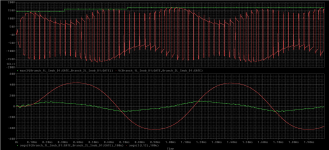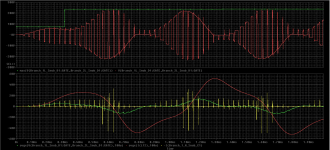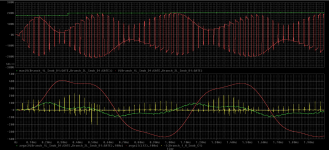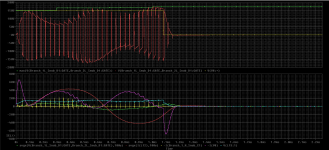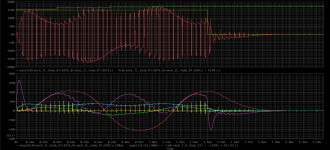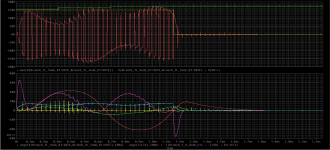zombiess
10 MW
This was inspired by a resurrection of Doctorbass's old thread about adding ceramic caps.
Adding caps to the DC rails can provide some minor improvement, but it often will not solve major turn off overshoot. Here are some simulations with relevant parasitic RLC parts modeled.
This layout has ~45nH of measured parasitic inductance (4nH on the DC Bus, if made lower the turn off overshoot will be lower). Testing is 1kHz sin, 30kHz bipolar PWM, 50V DC bus 2 parallel devices, full H bridge, 500ns dead time. 100uH/100mOhm load coil.
On the top graph, you can see the green line shows the maximum voltage reached, the red is what the input to the load coil looks like. The lower graphs show a 100us moving average of the voltage and current waveform. Green=V, Red=Amps
No snubbers at all
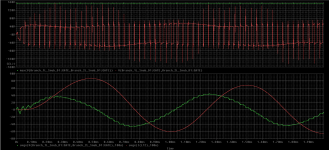
A overspec'd (designed for 400A, 150V bus) RCD snubber.

Adding 1uF cap to each half bridge

Adding 10uF cap to each half bridge

Adding 100uF cap to each half bridge (distributed DC link at this point)
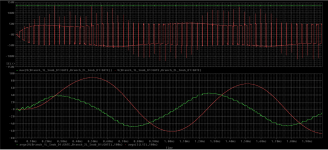
As you can see, adding more caps to the DC link can provide a small improvement, but nothing will beat a proper snubber design on a low inductance layout.
Adding caps to the DC rails can provide some minor improvement, but it often will not solve major turn off overshoot. Here are some simulations with relevant parasitic RLC parts modeled.
This layout has ~45nH of measured parasitic inductance (4nH on the DC Bus, if made lower the turn off overshoot will be lower). Testing is 1kHz sin, 30kHz bipolar PWM, 50V DC bus 2 parallel devices, full H bridge, 500ns dead time. 100uH/100mOhm load coil.
On the top graph, you can see the green line shows the maximum voltage reached, the red is what the input to the load coil looks like. The lower graphs show a 100us moving average of the voltage and current waveform. Green=V, Red=Amps
No snubbers at all

A overspec'd (designed for 400A, 150V bus) RCD snubber.

Adding 1uF cap to each half bridge

Adding 10uF cap to each half bridge

Adding 100uF cap to each half bridge (distributed DC link at this point)

As you can see, adding more caps to the DC link can provide a small improvement, but nothing will beat a proper snubber design on a low inductance layout.


